Latest updates on country situation
31 July 2024
In 2024, Spain has seen a significant surge in sea arrivals among migrants, refugees, and asylum seekers through the Western Mediterranean route. Between January–June, the arrivals numbered nearly 25,000, representing a 96% increase compared to the same period in 2023. Most are from West Africa, and they predominantly reach the Canary Islands, which witnessed a 167% increase in arrivals during the first half of 2024. Political instability, economic hardship, and climate crises are among the key drivers of migration to Europe, including Spain. The journey across the Western Mediterranean is often dangerous, with people travelling in overcrowded and unseaworthy boats, leading to a high risk of drowning. During the journey, many also suffer from dehydration, starvation, and exposure to harsh weather conditions, besides exploitation by human traffickers. Upon arrival, they often face uncertain legal status, a lack of necessities, and inadequate shelter and medical care. (MMC 24/07/2024, InfoMigrants 18/07/2024, STC 14/05/2024)
07 February 2024
Over 57,000 undocumented migrants and asylum seekers arrived in Spain in 2023 via the Western Mediterranean route, 91% more than in 2022. Many transited through Morocco and Algeria from Sub-Saharan Africa. In the same year, the number of dead or missing migrants and asylum seekers reached nearly 1,150, slightly less than in 2022. The migration journey continues to be difficult, putting people’s lives at risk. Boats often capsize, or people remain stranded at sea awaiting rescue. Upon arrival, migrants and asylum seekers often rush the border fence at Melilla and face border guards’ excessive use of force and interception and detention by Moroccan authorities. In 2023, Morocco intercepted nearly 87,000 migrants and asylum seekers. Documented needs include medical attention, protection, registration assistance, and community engagement services. (UNHCR accessed 02/04/2024, TBP 15/05/2023, IM 05/02/2024)
05 July 2023
Between 15 June and 1 July 2023, at least 90 migrants, refugees, and asylum seekers died while attempting to cross from Morocco to Canary Islands, Spain. As the weather improved in June, the migration movement over the Western Mediterranean route increased. About 2,600 migrants arrived in Spain that month alone, while 4,400 arrivals were recorded between January–May 2023. The majority of migrants are from Ethiopia, Gambia, Senegal, Sri Lanka, and Sudan, and they seek migration to escape insecurity and worsening economic conditions in their countries. The use of wooden or inflatable boats and overcrowding are some of the factors leading to more accidents in the Mediterranean. On 21 June, a lack of coordination between rescue teams in Spain and Morocco contributed to the delayed rescue of a boat that eventually capsized, killing at least 37 people. Generally, new arrivals to Spain need medical attention and registration assistance. (InfoMigrants 03/07/2023, BBC 23/06/2023, UNHCR 28/06/2023)
current crises
in
Spain
These crises have been identified through the INFORM Severity Index, a tool for measuring and comparing the severity of humanitarian crises globally.
ESP002 - International displacement
Last updated 20/11/2025
Drivers
International Displacement
Crisis level
Country
Severity level
1.5 Low
Access constraints
0.0
Analysis products
on
Spain
07 April 2017
Humanitarian Response Plan 2022
DOCUMENT / PDF / 901 KB
ACAPS and the International Federation of Red Cross and Red Crescent Societies have produced a new set of Central and West Mediterranean migration scenarios, outlining possible developments in migration via Libya, Italy, Spain and other transit countries over the next six months.
18 March 2016
The Balkans: Asylum Seekers, Migrants, and Refugees in Transit
DOCUMENT / PDF / 777 KB
As of 16 November, close to 820,000 people have arrived in Europe by sea in 2015. 85% of the arrivals are from the world’s top ten refugee-producing countries. As the sea route to Italy via North Africa is longer and more risky, and as the number of Syrians has increased, more people are travelling through Greece and then through the Balkans to reach northern and western Europe.



